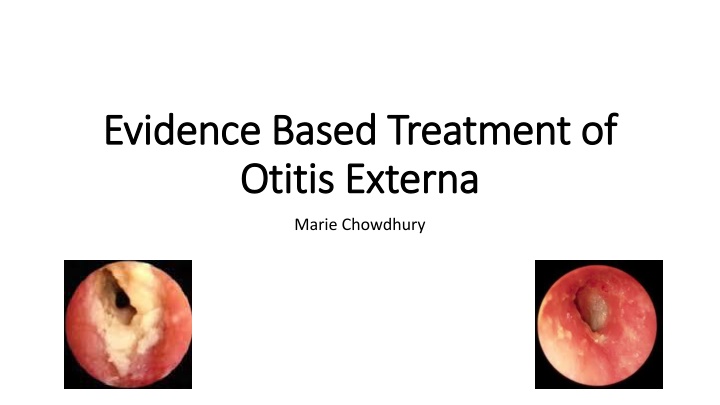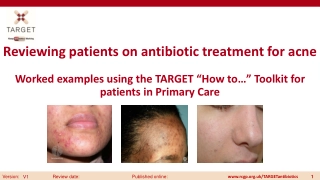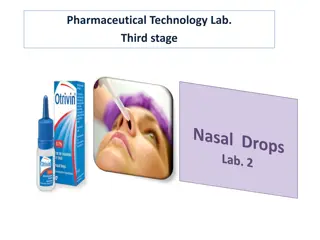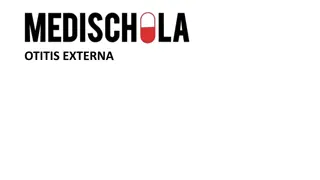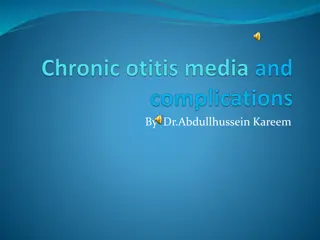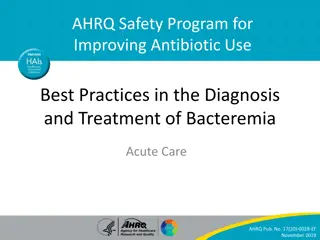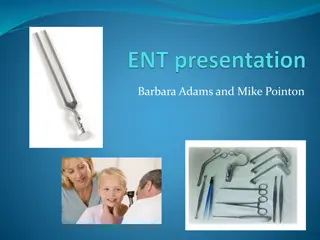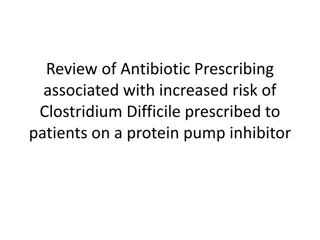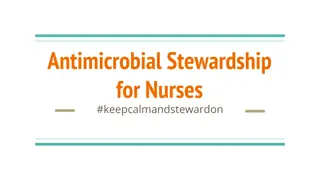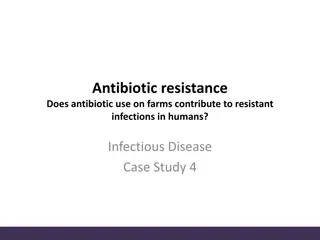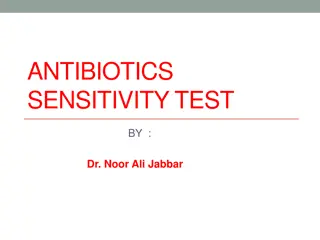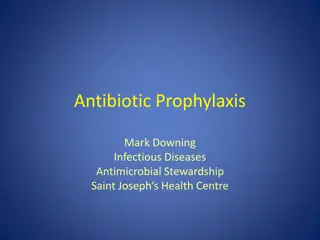Evidence-Based Treatment of Otitis Externa: Topical Antibiotic/Steroid Drops Effectiveness Review
Clinical guidelines for treating acute otitis externa recommend using topical antibiotic/steroid drops based on the severity of symptoms. This review explores the effectiveness of this treatment approach compared to using only topical antibiotic drops in primary care settings. Search strategies in medical databases yielded several relevant papers discussing the use of steroids and antibiotics in treating external ear infections, with varying results and recommendations.
Download Presentation

Please find below an Image/Link to download the presentation.
The content on the website is provided AS IS for your information and personal use only. It may not be sold, licensed, or shared on other websites without obtaining consent from the author.If you encounter any issues during the download, it is possible that the publisher has removed the file from their server.
You are allowed to download the files provided on this website for personal or commercial use, subject to the condition that they are used lawfully. All files are the property of their respective owners.
The content on the website is provided AS IS for your information and personal use only. It may not be sold, licensed, or shared on other websites without obtaining consent from the author.
E N D
Presentation Transcript
Evidence Based Treatment of Evidence Based Treatment of Otitis Externa Otitis Externa Marie Chowdhury
Clinical Scenario Clinical Scenario 50 yo man with a one day hx of a painful left ear. Also some reduced hearing and creamy discharge in affected ear. O/E: Apyrexial tender on pushing on tragus erythematous but NOT swollen ear canal with small amount of creamy/yellow discharge TM slightly pink but no evidence of perforation of otitis media Tx: gentamicin only topical ear drop for 7-10 days and tcb if not improved or worse with next two days. Thought process: Ear canal not swollen and no perforation seen (or suspected) so decided against topical steroid drops and off licence ciprofloxacin drops. Supervising GP said he would instead have prescribed a combination of antibiotics and steroid drops for any kind of otitis externa.
Local and National Guidelines Local and National Guidelines Oxfordshire Adult Antimicrobial Prescribing Guidelines For Primary Care: Aural toilet (if available) and analgesia 1stline: Acetic acid 2% TDS for 7 days 2ndline: Betnesol-N (neomycin and corticosteroid) TDS for 7-14 days CKS NICE Guidelines: Mild cases (mild pruritus and pain and no deafness or discharge): Acetic Acid 2% More severe cases (deafness and discharge present) or if acetic acid not successful: topical antibiotic with or without a topical steroid. Decision of which preparation will depend on risk of s/e, patient s preferences and cost.
Three Part Question Three Part Question Clinical problem: Are topical antibiotic/steroid drops the most effective way to treat acute otitis externa? In patients presenting to primary care with acute otitis externa are topical antibiotic/steroid ear drops better than topical antibiotic ear drops at reducing symptoms and treating acute otitis externa?
Search Strategy Search Strategy PubMed Steroid AND Antibiotics AND otitis externa : 6 relevant papers out of 15 results Steroid* AND Antibiotics* AND external ear infection : 0 relevant papers out of 1 result primary care AND otitis externa : 2 relevant papers out of 33 results TRIP: P: otitis externa I: antibiotic C: steroid O: left blank : 1 relevant paper out of 4 results. otitis externa antibiotics : 7 relevant papers out of 192 results Cochrane: otitis externa : 1 relevant paper out of 3 results
Search Strategy Search Strategy After accounting for overlapping titles: 11 papers found to be relevant 3 Systematic Reviews with meta-analyses 6 RCTs ( 2 unable to access) 1 Clinical guideline (USA) 1 Survey (UK)
Search Outcome Search Outcome After accounting for overlapping titles: 11 papers found to be relevant 3 Systematic Reviews (meta-analyses in 2 of them) 6 RCTs (2 unable to access) 1 Clinical guideline (USA) 1 Survey (UK) I decided to appraise the 3 systematic reviews I found one RCT relevant to the question that had been recently published and thus not included in the systematic reviews.
Relevant Papers Relevant Papers Systematic Review: Kaushik V, Malik T, Saeed S. Interventions for acute otitis externa. Cochrane Database of Systematic Reviews 2010 Systematic Review: Rosenfeld R. Systematic review of topical antimicrobial therapy for acute otitis externa. (2006) Systematic Review: Hajioff D, MackeithS. Clinical Evidence: Otitis externa. 2015 RCT: Lorente L. Ciprofloxacin plus fluocinolone acetonide versus ciprofloxacin alone in the treatment of diffuse otitis externa. (2014)
Cochrane SR Rosenfeld SR Clinical Evidence SR Clearly focused question? No To determine the effectiveness of different methods of treating OE Outcomes well defined Yes/No To determine the efficacy of topical antimicrobial for acute OE (but included steroids in antibiotic arm) Outcome: strived for binary outcome data only No what are the effects of empirical treatment for OE? Outcomes well defined Appropriate papers? Yes: 19 RCTs Yes/No: 20 RCTs Yes: 10 RCTs and 1 SR Where the relevant studies included? Yes: DB and SB RCTs only Very thorough search: contacted authors, reference list, included search strategy in appendices Sample size 21 601 6 RCTs had pharmaceutical support Yes but: RCTs with binary data 50% of trials were DB Included open trials Sample size 28-842 Most studies did not declare financial support, 20% had pharmaceutical support Yes/No: DB and SB RCTs only with minimum 20 participants and 80% f/u (not less than 1 month) Limited to English only papers Was the quality of the studies assessed? Yes: based on sequence generation, allocation concealment and blinding. Only 3 trials were of high quality. Yes: Jadad score 50% had a low quality rating of 2 or below. Only 4 studies were run with an ITT Yes: Grade analysis 9 trials very low or low quality
Cochrane SR Rosenfeld SR Clinical Evidence SR Was it reasonable to combine the results? Yes: 3 meta-analyses only combined outcome results which were collected at same time period No: pooled results from trials with different steroid, antiseptic and antibiotic active components (Heterogenity was found to be due to different potency of steroids) Unsure: 13 meta- analyses Pooled trials with different active components so No meta-analysis as not enough trials with same intervention and control arms What are the overall result? Please see next slide Please see next slide Please see next slide Can the results be applied to the local population? Yes: Most studies from USA, UK and EU so results applicable No: Most studies set in a secondary care setting Majority of studies had micro- suction performed Only 3 studies were run with an ITT protocol Same concerns as Cochrane SR Same concerns as Cochrane SR
Comparisons Cochrane SR Rosenfeld SR Clinical Evidence SR Antibiotic/steroid vs Placebo Significant difference in favour of antibiotic/steroid (1 RCT) OR 11 CI 95% Significant difference in favour of antibiotic/steroid (2 RCTs) P<0.001 No significant effect (1RCT) Quinolone vs aminoglycoside No significant difference (1 RCT) No significant difference (7 RCTs contained steroids in some) Antibiotic/steroid vs antiseptic Significant effect in favour of antibiotic/steroid (1 RCT) at 3-6 weeks (why 2 excluded?) OR 3.12 CI 95% Significant effect in favour of antibiotic/ steroid OR 3.12 Antibiotic/steroid vs antiseptic steroid No significant difference (1 RCT) Antibiotic/steroid vs antibiotic No significant difference when 3 RCTs combined No significant difference (3 RCTs) Antiseptic/steroid vs antiseptic Significant difference in favour of antiseptic/steroid (3 RCTs) OR 4.82 95% CI No significant effect (1RCT) Antibiotic/steroid vs steroid No significant difference (1RCT) Significant difference in favour of steroid (2 RCTs) P< 0.021
Relevant RCT not included in SRs Relevant RCT not included in SRs 2014 Multi-centre, randomised, parallel group, double blinded clinical trial involving 590 patients Comparison of clinical efficacy between ciprofloxacin/steroid drops and ciprofloxacin drops Does not set out if in secondary or primary care setting or if micro-suction was undertaken No f/u beyond 8 days No mention of how participants were randomised, balanced or allocation sequence. Results: Significant difference in clinical efficacy at end of treatment, and total symptom score in favour of the ciprofloxacin/steroid drop. P=0.01 However no significance with regards to duration of otalgia
Clinical Bottom Line Clinical Bottom Line 3 systematic reviews based on predominantly low quality studies so effect size may be exaggerated. With regards to my question: according the SRs no evidence that antibiotic/steroid drops have a better cure rate or prevents recurrence better than antibiotic drops. However: Causes of OE is varied and one should be mindful of clinical picture (a very swollen ear canal would probably require a steroid component) Multitude of treatment options so difficult to get enough evidence of a particular treatment in order to undertake a sound meta-analysis Recent RCT suggests antibiotic/steroid combinations have a significant effect over antibiotic only drops on resolution of sx. It might be better to use anticeptic/steroid or antibacterial/steroid combinations drops rather than simple acetic acid drops in all cases but very mild OE. Generability: poor due to nature of RCTs (based in secondary care, micro-suction undertaken introducing confounding and not available in primary care and scarce ITT analysis) Adverse effect mild and few so choice of treatment should be one based on cost, minimising s/e and patient preference as set out in the CKS guidelines.
References References Kaushik V, Malik T, Saeed S. Interventions for acute otitis externa. Cochrane Database of Systematic Reviews 2010, Issue 1. Rosenfeld R, Singer M, Wasserman J, Stinett S. Systematic review of topical antimicrobial therapy for acute otitis externa. Otolaryngology-Head and Neck Surgery (2006) 134, S24-S48. Hajioff D, MackeithS. (2015) Clinical Evidence: Otitis externa. 2015;06:510. Lorente L, Sabater F, Rivas M, Fuste J, Risco J, Gomez M. Ciprofloxacin plus fluocinolone acetonide versus ciprofloxacin alone in the treatment of diffuse otitis externa. The Journal of Laryngology & Otology (2014), 128, 591-598. https://www.bestbets.org CASP checklist (Practice of Evidence Based Health Care CEBM)
